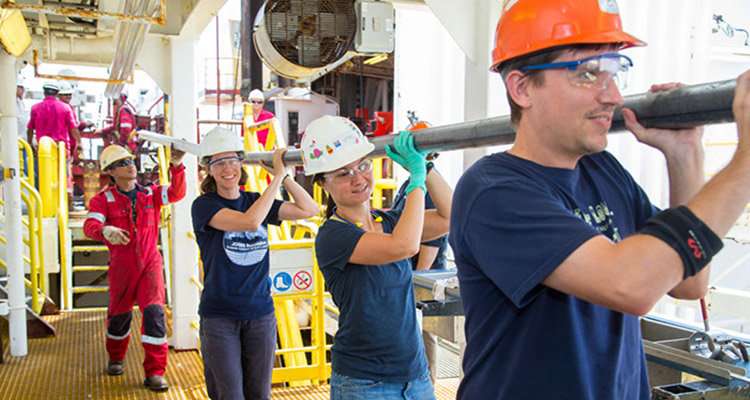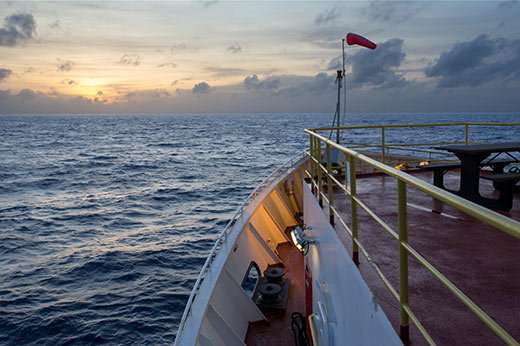Mining for answers in the ocean's archives

With a death toll of more than 250,000 people, the Boxing Day tsunami of 2004 was one of the most devastating disasters of recent history.
It was triggered by an earthquake that struck off the coast of Sumatra in Indonesia. In 2016, Professor Lisa McNeill led a scientific exhibition to investigate where it all began—in the seabed.
Lisa said: "Sampling an earthquake zone in situ is one of the holy grails of modern earthquake studies. Although we now have very sophisticated techniques to remotely record the earthquake process, we really needed to sample the rocks where the real action goes on."
The expedition was conducted by the International Ocean Discovery Program (IODP), which for the past 50 years has been sending scientists, researchers, engineers and technicians across the world to delve into the Earth's archives.
Secrets of the deep
By drilling deep beneath the ocean, IODP expeditions extract samples of ancient sediments and rocks, which contain a detailed record of how the planet has evolved over millions of years. In the case of the Boxing Day tsunami, those sediments had become compacted over the course of nine million years. As temperatures rose, they got stronger and denser, eventually leading to the shift in tectonic plates that triggered the earthquake.
In 2011, the world was stunned by another tsunami, this time in the Tōhoku region of Japan, which claimed 20,000 lives, destroyed 230,000 homes and generated the Fukushima nuclear meltdown. Just over a year later, scientists sailed out to the Pacific Coast to investigate. Before this expedition, people used to think that earthquakes got weaker as they travelled up through the Earth. But this research trip found out that the Tōhoku earthquake actually got stronger and stronger as it neared the ocean floor.
These findings could help scientists predict the likelihood of future natural hazards in regions with similar geological conditions. Policymakers could use the evidence to create greater safeguards for coastal communities.

Changes in the water
As well as earthquakes, scientific data like this captured by the IODP is one of the most powerful indicators of climate change. It shows a warming climate, rising sea levels, melting ice sheets and natural hazards. The International Panel on Climate Change (IPCC) relies on data like this to influence environmental policies that determine how the world responds to climate change.
In its 2013 report, the IPCC referenced investigations led by Professor Stephen Barker, who uses IODP deep core sediments to understand climate change in the past. His team found that during the last ice age (110,000 to 12,000 years ago), in the Northern Hemisphere, temperatures rose intermittently by more than ten degrees Celsius within a few decades. While, over the same period, temperatures in the Southern Hemisphere changed more gradually.
Warmer water temperatures cause sea ice to melt, which adds freshwater to the ocean, raising the sea level. The oceanic changes documented by scientists provided the IPCC with the first concrete evidence of how climate change impacts the way water circulates around the ocean. Ocean circulation is important because it has a huge effect on weather and climate conditions in different regions, as the movement of water distributes the heat that the ocean absorbs.
The tide is rising
The state of the world's oceans tells us a lot about climate change. Oceans have absorbed a lot of the excess heat caused by global warming and that causes the water to expand—pushing up sea levels. Ocean levels could rise by a few feet by 2100, which, for the 150 million people living within three feet of current ocean levels, would have serious consequences.
A heated debate
Professor Carrie Lear is working to understand how levels of ice around the globe have changed over time.
Carrie said: "The long sediment cores drilled by the IODP provide records of climate change and ice volume change over millions of years."
Records like this recently made the scientific community realise that the Antarctic ice sheet is much more susceptible to change than previously thought. Findings like this are important for policymakers.
Carrie added: "Sea level change due to global warming this century could be larger and more rapid than previously thought. This means that we need more stringent policies to be made now if we are to minimise the effect on sea level rise by the end of the century."
Provided by PlanetEarth Online
This story is republished courtesy of Planet Earth online, a free, companion website to the award-winning magazine Planet Earth published and funded by the Natural Environment Research Council (NERC).



















